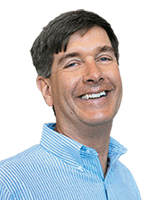Clark Talks Turf: What spectral reflectance data tells us

Clark Throssell
Josh Friell, Ph.D., is a senior principal research scientist at Toro’s Center for Advanced Turf Technology. Josh devotes his time to advancing the acquisition of soil and plant data and determining how to use that data to make decisions that benefit the golf course. You may reach Josh at josh.friell@toro.com for more information.
Q: Describe the process of collecting spectral reflectance data on a golf course.
There are three approaches to collecting spectral reflectance data from golf course turf. The first is a handheld or vehicle-mounted sensor that intercepts reflected light from a small area of turf. The data are averaged over the area to yield a single data point. The second is a camera mounted on an unmanned aerial vehicle (UAV) that collects reflectance data at prescribed intervals over a large area. The data are then uploaded to a computer for analysis. The third approach is a subscription to a satellite imagery service that collects low-resolution reflectance data from large areas on an infrequent basis. The data are then analyzed.
Q: Provide background on the theory behind using spectral reflectance data to monitor turf health.
The material properties of all objects, including turf, determine how light will be absorbed, transmitted and/or reflected. Spectral reflectance is light being reflected from an object, and in our case, reflected from turf. Chlorophyll absorbs red and blue light and reflects green light. The more chlorophyll turf contains, the healthier it presumably is, and the more red light it will absorb. Healthy green plants reflect near-infrared light. The more near-infrared light reflected from a green turf canopy may indicate more biomass present and presumably indicates a healthy stand of turf.
By comparing the ratio of different wavelengths of light reflected from a plant canopy, scientists have developed various indices to gauge plant health. One of the most widely used indices is NDVI, or Normalized Difference Vegetation Index. NDVI is calculated using the red (visible) light and near-infrared light reflected by turf.
Q: What does spectral reflectance data indicate to a superintendent?
Spectral reflectance data, which are used to calculate NDVI, indicate turf in one area is different from turf in an adjoining area. The difference in NDVI between the two areas indicates there is a difference in chlorophyll content and/or turf biomass between the two areas, and presumably turf health. The superintendent should investigate the difference in turf quality between the two areas. NDVI does not give an indication as to what the specific problem may be.
Q: What does spectral reflectance data not indicate to a superintendent?
Spectral reflectance data, as expressed by NDVI, does not provide information as to what the problem is or isn’t. The hope is that we can use spectral reflectance in specific wavelengths of light to diagnose a specific problem, such as dollar spot. Much research remains to be completed before we have any idea if we can use reflectance indices alone to diagnose a specific problem.
Q: What’s next in spectral reflectance research in the coming two or three years?
One focus is on combining two different types of data to help make decisions. An example is combining spectral reflectance data with soil moisture data collected using in-ground soil moisture sensors. If spectral reflectance data show turf stress simultaneously with soil moisture data showing a decline, this most likely indicates the turf lacks sufficient water. If this condition occurs, we can use the combined data to guide irrigation decisions.
Q: Is there anything else you would like to add?
There is a great deal of excitement about UAVs (drones). However, it is important to keep in mind a UAV is simply a delivery mechanism for the spectral reflectance sensor. Our focus needs to be on the data collected by the sensor and how to interpret the spectral reflectance data.










